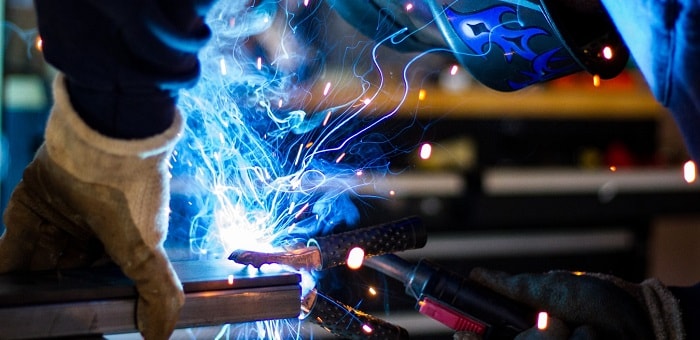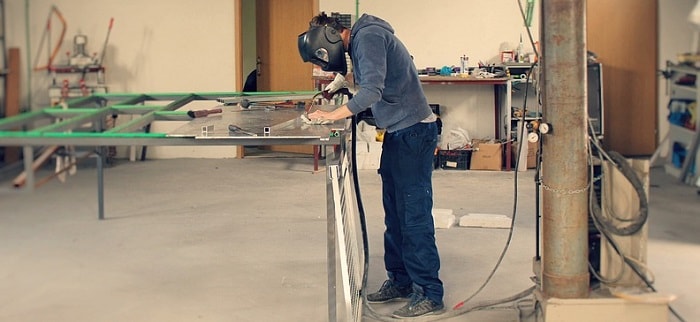One of the great things about plastic is that it is indeed plastic and has the attribute of plasticity. In plain English, that means under the right circumstances, many kinds of plastic can be deformed but also they can be joined to other pieces of plastic.
To do that, the molecular bonds in the sections of plastic you want to join need to be loosened and made malleable, extrudable and generally able to re-bond with new molecules.
How Does Plastic Welder Work
The two common ways to do that are:
- chemical (via applying a solvent, which as the name suggests loosens things up by partially dissolves the plastic);
- or applying heat (which is in fact atomic and molecular motion, which again loosens things up).
While in this loosened state, the plastic is amenable to being welded. This is much like humans when drinking enough Martinis or Vodkas, but we’ll stop that analogy there.
In another itech article, we looked at some of the top rated plastic welders. It’s very much ‘horses for courses’ as there is no ‘best’. There are roughly 14 different ways to perform heat welding and each has plusses and minuses.
Some are OK for the hobbyist, like air-driven heat guns, airless contact point heaters, etc. then some industrial-grade exotica, like James Bond-style laser, vibration and ultrasound welders.
However, the principle remains the same – loose the bonds in both surfaces via energy, then apply pressure to join the two different sets. It’s tempting to do a Bond joke at this point but that’s would be too obvious.
The quality of the bonded result depends on the kind of plastic being bonded, correct preparation of the surfaces, ensuring that there is no moisture or impurity that might mess things up and most of all getting exactly the right amount of heat.
Different plastics have different heat characteristics and some bond way better than others (some hardly bond at all). Too little heat and you’ll get a poor join, too much heat and the plastic’s molecular structure will move from simply loosening to actually starting to get damaged or destroyed. Then the two plastic will not fuse correctly or will fuse but you won’t get a clean edge.
Thermoplastics are generally easier to work with and produce better results than other kinds of plastic because of their innate ability to be repeatedly heated, melted, cooled and solidified.
Another key point is that you generally get much better results welding identical types of plastic to each other and it’s equally the case that it can be difficult or even impossible with some combinations to get a good looking result – or indeed any kind of result.
So, finding out what kind of plastic you are welding is really important before you start the job.
Since you can only really weld similar materials, it follows you must first identify the material to be welded which is fine when they are stamped with plastics identification codes. However, where this identification is missing, you will need to do a careful welding test to correctly identify the plastic material to be welded.
It’s also the case that some plastics change in nature over time – especially those that live outdoors and are exposed to the sun, wind, rain, etc.
Aging brittle plastic poses real challenges for welding – which is unfortunate since that is one area where welding is popular as a way of refurbishing old bumpers, plastic on houses, boats, toys, etc.
So, in a nutshell, a plastic welder works by breaking and reforming molecular bonds and good plastic welding needs some research and preparation beforehand plus the right tools and some skill.
How Does Plastic Welding Work
The welding process does not change the plastic. The ultrasonic vibration creates heat that welds two pieces of plastic together without melting it, and there is no exposure to molten metal or toxic fumes during this process.
After the plastics are placed in a container with water on one side and air pressure on the other, an electric current will create waves of sound waves inside the pressurized area.
These vibrations will bond any clear piece of polyethylene (HDPE) as long as they have both been heated up by boiling them before hand for five minutes prior to placing them into the machine where they will be bonded.
This happens because when you put two different types of polymers next to each other from opposite sides, so that their molecules line up, the molecules vibrate at resonant frequencies. This causes heat to be created that will welds both pieces of polymer together.
The process requires that one side of each piece be heated by boiling it for five minutes before placing them into the machine. After they are bonded, a seal is made which can hold air or liquid until either breaks down over time due to deterioration from UV rays and weather conditions.
The process does not change the plastic but instead changes its molecular structure in order to create bonding properties between two pieces without melting any material at all like traditional welding processes would do in other materials such as metals…
How To Use a Plastic Welder
To use a welder, you need an electric current and two pieces of metal. You also need to know how the different types of welders work: gas or arc welding and electric wire feed.
For example, with a gas welder, molten metal is released by torch in which case it reacts with oxygen from the air.
For arc welding there’s no fuel needed but instead some form of electricity arcs through an area between two electrodes (for this type of technique almost all wires are made heated).
Then just like any other tool that operates on electricity or can produce fire sparks when used improperly, always be careful not to touch live parts while using your plastic welder because they may shock you or burn you badly if touched without being insulated.
After reading this, the reader will know how to use a plastic welder and have some knowledge about different types of welders as well. They should also be aware of safety precautions when using any tool that can produce sparks or shock them.
The content in bullet points is not needed for long-form content, but may help you organize your thoughts better if they are written down before continuing writing from scratch so that it’s easier to transition between sections later on.
Thanks for reading 😉

Having studied electronics, Dave has worked on installing networking and IT systems especially using Cisco technology.
A review from Dave is usually skeptical about “comparing apples with oranges” For Dave, it is all about finding products that work for specific individuals and their needs.
Dave takes full advantage of living in California and in addition to golf, has tried it all when it comes to action sports, including enjoying snowboarding, skiing, windsurfing, and white-water Kayaking.




